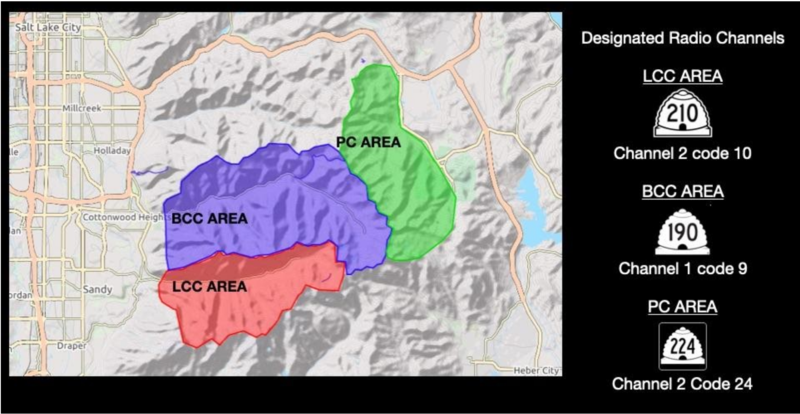This winter the Utah Avalanche Center, in partnership with Backcountry Access, will be implementing regional common-use radio channels for the Wasatch Range. These channels are designed to better facilitate group-to-group communication in the high-use backcountry areas of the Wasatch. These frequencies are in the Family Radio Service (FRS) bands and do not require a license from the FCC for use.
Regional Group Monitoring Channels-
- Little Cottonwood Canyon/Highway 210: Channel 2 Privacy Code 10
- Big Cottonwood Canyon/Highway 190: Channel 1 Privacy Code 9
- Park City Ridgeline/Highway 224: Channel 2 Privacy Code 24
- Rescue Channel (when a rescue is underway): Channel 9 Code 11

How it works-
The canyon and drainage you’re traveling in corresponds with a highway and you get on the radio frequency that aligns with the highway designation (LCC- 210, BCC-190, PC-224). If you decide to change drainage and canyons along a ridgeline, you simply switch to that highway/drainage frequency-
Scenario 1-
You're hiking up Flagstaff, but might plan to eventually drop into Days. On the up you're in LCC so you're tuned to Channel 2 Code 10 (Hwy 210). If you ski towards LCC road you stay on Channel 2 Code 10. If you grab the ridge and drop towards BCC (Hwy 190) you switch to Channel 1 Code 9 (there's no privacy code 90 so you just eliminate the zero).
Scenario 2-
Starting in BCC you’re tuned to Channel 1 Code 9 (Hwy 190) headed up USA Bowl. On the PC Ridge you decide to drop into the Monitors. You're going towards PC Drainages and Channel 2 Code 24 (Hwy 224).
These channels are intended for groups to monitor prior to dropping in on terrain, while in terrain and if groups come across hazards, avalanches, incidents, etc. while in the terrain. These radio channels are not to be used in the case of an emergency. Please call 911 directly if you need rescue.
If your group is intending to chat a lot about snow conditions, safety locations, setting up photos, etc., please use an alternative channel and report back to the regional channels when appropriate. DON’T JAM UP THE COMMON-USE FREQUENCIES WITH UNNECESSARY CHATTER!
Intended Uses & Radio Protocols:
- A way for riders to communicate with people within their party and more importantly communicate with potential groups below and above you and your group.
- To send a distress call to your group and other parties to aid in self rescue and to alert of potential threatening avalanche hazards.
- To ask for someone to call 911 to mount an organized rescue, when 911 can’t be reached directly on your own.
- Radio communication between partners at areas of safety
- Radio communication regarding potential hazards, snow and avalanche information
- Radio communication when you and your group are clear of a given line or area
Radio Communication between you and your group:
- Radio communication between partners at areas of safety
- Radio communication regarding potential hazards, snow and avalanche information
- Radio communication when you and your group are clear of a given line or area
- General communication
Radio Communication between multiple groups:
- Route selection and timing to avoid riding directly above other groups
- Radio communication regarding potential hazards, snow and avalanche information
- Radio communication when your group is clear of a given line or area, alerting other groups of a clear run-out zone
- General communication
Backcountry Access radios are available for purchase at www.backcountryaccess.com.
Good Reads:



